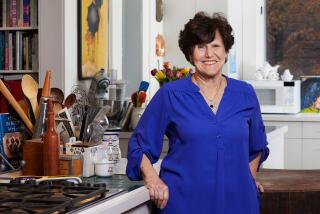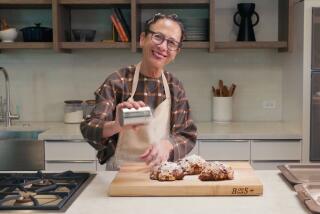6 of the year’s best baking books, plus Dorie Greenspan’s matcha financier recipe
2014 has been a pretty fantastic year for baking books, with bakers and pastry chefs here in Los Angeles and around the country publishing books that are both pretty to look at and surprisingly user-friendly. These books also, perhaps needless to say, make excellent gifts this time of year for those on your list with a propensity for spending their weekends baking cookies, loading their ovens with sprouted wheat challah or trying to master the cronut. Right.
—Local baker extraordinaire Zoe Nathan (Huckleberry, Milo & Olive, Rustic Canyon) came out with her first book, written with husband and business partner Josh Loeb and fellow baker Laurel Almerinda. “Huckleberry” (Chronicle Books) is a beautiful book (the photography is by Long Beach-based Matt Armendariz), with photographs not only of Nathan’s artful yet homey recipes (blueberry nectarine crisp, apple cinnamon hand pies) but also instructional steps.
Thus we get visuals on how to line cake pans, and how to form galettes — visual aids that are not only gorgeous, but also worth pages of text. The text itself is fun, with little stories from Nathan’s restaurants, out-takes from her bakery and pastry kitchen, as well as from her own life, raising kids and baking breads. It’s a lovely, cozy book, one that not only teaches you how to make scones but leaves you really, really wanting to both bake and eat them.
—”Bread Revolution” (Ten Speed Press) is baker, baking instructor and pizza guru Peter Reinhart’s latest book, in which he delves (further) into the world of whole grains and heirloom flours. Reinhart has long been one of our foremost bakers, and he championed sourdough and whole grain baking long before others did.
This book moves between basic instruction (how to properly scoop flour, how to make a sourdough starter) and advanced technique (using grape skin flour, making starter with peach water), while keeping Reinhart’s down-to-earth narrative and tone. With great photography by Paige Green and lots of sidebars and introductions on everything from whole grain milling, why it’s worth bothering with an egg wash, shaping pizza dough and forming whole grain croissants, it’s a fun book for both novices and advanced bakers.
—Nick Malgieri, who directs the baking program at New York’s Institute of Culinary Education, writes lots of books (12 so far), the most recent of which is “Nick Malgieri’s Pastry” (Kyle Books). This one covers the pastry spectrum, from tarts to pies to laminated dough and pate a choux.
Malgieri’s book is highly accessible, with many great instructional, step-by-step shots (by Romulo Yanes). This, coupled with the many sidebars on techniques, ingredients and tips, makes this a very good book for beginners.
There’s also plenty for the would-be pastry chef, and Malgieri includes a terrific section on Turkish pastry, with recipes for baklava, yufka and borek, as well as recipes for the pastries of other cultures (strudel, empanadas, pithiviers).
—Another veteran baking author who came out with a book this year is Rose Levy Beranbaum, whose “The Baking Bible” (Houghton Mifflin Harcourt) is as impressive as it sounds. Beranbaum, whose previous excellent books include “The Cake Bible” and “The Bread Bible,” takes — as you’d expect from the title — a happily comprehensive approach.
This is perhaps not the book for the beginner, but rather the encyclopedist baker, one who appreciates Beranbaum’s thorough information: baking times and oven temperatues; recipes that include measurements given in volume and weight, both ounces and grams; and the extensive notes on equipment and technique. That said, sometimes a thorough approach is really fun, as with Beranbaum’s recipe for her chocolate chip cookies, which calls for clarified brown butter and toasted walnuts.
—If you, like most of the rest of the world, lost your mind a bit when New York pastry chef Dominique Ansel invented his cronuts, then maybe you need to own his new book, “The Secret Recipes” (Simon and Schuster). This is Ansel’s first book, thus it tells a bit of his back story, as well as documenting plenty of recipes other than the famous croissant-doughnut hybrid. But yes, it’s there: on page 201. Knock yourself out.
But there are many reasons to get the book other than that famous pastry. Before he invented the cronut Ansel ran a bakery, and before that he was the pastry chef at Daniel Boulud’s flagship restaurant. Thus you’ll find lessons on tempering chocolate, laminating dough, making and piping pate a choux, plus recipes for a black and blue pavlova (blackberries, violet food coloring), even S’mores and tiny egg sandwiches.
—And then of course, there’s Dorie Greenspan’s latest book, “Baking Chez Moi” (Houghton Mifflin), which is the prolific baker’s ode to French baking (Greenspan has had a home in Paris for many years). Having written not only many of her own books but also books with Parisian pastry chef Pierre Herme, you can guess how much and how well she writes about this subject.
There’s much here for both the relative novice and the experienced baker, with recipes for Nutella buttons (mini cupcakes), “the rugelach that won over France,” bubble eclairs, pithiviers, profiteroles, “les Whoopies” — even the humble chocolate chip cookie, this one via a Parisian bistro owner. As always, Greenspan’s books are fantastically readable, with notes and sidebars on things like silicone spatulas and coulis, which are here, charmingly, called “bonne idees.”
This book under someone’s tree (or your own)? A bonne idee, indeed. Another good idea would be making these matcha financiers — colored beautifully green not by dyes but by the Japanese green tea — for your holiday tree party.
MATCHA FINANCIERS
From Dorie Greenspan’s “Baking Chez Moi.” Makes 30 mini cakes. This recipe was not tested in the Times’ Test Kitchen.
Note: Matcha is a very expensive tea, and not one you’re likely to find on every supermarket shelf. It comes in grades, and the highest grade is unnecessary for baking. Look for a culinary- or commercial-grade tea; I use Harney & Sons Matcha Culinary Grade.
1 1/2 sticks (12 tablespoons; 6 ounces; 170 grams) unsalted butter, cut into chunks
2/3 cup (90 grams) all-purpose flour
1 1/2 teaspoons matcha green tea (see above)
Pinch of fine sea salt
1 cup (200 grams) sugar
1 cup (100 grams) almond or hazelnut flour
6 large egg whites, at room temperature, lightly beaten
1. Heat the butter in a small saucepan over medium heat until it starts to boil, then boil for 1 minute; it may color ever so slightly, but you don’t want it to brown. Remove the pan from the heat and set it aside (you want the butter to be warm when you add it).
2. Whisk the all-purpose flour, matcha and salt together in a small bowl.
3. Using a flexible spatula, stir the sugar and nut flour together in a large bowl. Gradually add the egg whites, stirring to moisten the dry ingredients.
4. When all the whites are in, give the mix a few vigorous stirs. Stir in the all-purpose flour mixture, mixing only until it’s evenly blended, then start adding the melted butter, a little at a time, folding and stirring the batter until all the butter is in, a feat that will seem miraculous. You’ll have a pea-green batter with a sheen to it.
5. Press a piece of plastic film against the surface of the batter and refrigerate for at least 1 hour. (The batter can be refrigerated for up to 3 days.)
6. When you’re ready to bake: Center a rack in the oven and preheat the oven to 400 degrees F. Butter the cups of a mini muffin tin (or tins; you can make as many or as few financiers as you want — there’s enough batter for 30), dust with flour and tap out the excess (or use baker’s spray, a mix of vegetable oil and flour).
7. Spoon the batter into the muffin cups, filling them almost to the top.
8. Bake the financiers for 12 to 14 minutes, or until they have crowned and feel springy to the touch; their tops may have cracked, and that’s fine. They’ll be browned around the edges (and on the bottom) and a beautiful green in the center.
9. Remove the tin(s) from the oven, wait 1 minute, then tap them against the counter to encourage the financiers to tumble out. Pry any stragglers from their molds with a table knife. Transfer the financiers to a rack and let cool until they are just warm or at room temperature.
Excerpted from “Baking Chez Moi,” © 2014 by Dorie Greenspan. Reproduced by permission of Houghton Mifflin Harcourt. All rights reserved.
Lotsa pictures of bread and cookies on Instagram @ascattergood.
More to Read
Eat your way across L.A.
Get our weekly Tasting Notes newsletter for reviews, news and more.
You may occasionally receive promotional content from the Los Angeles Times.







